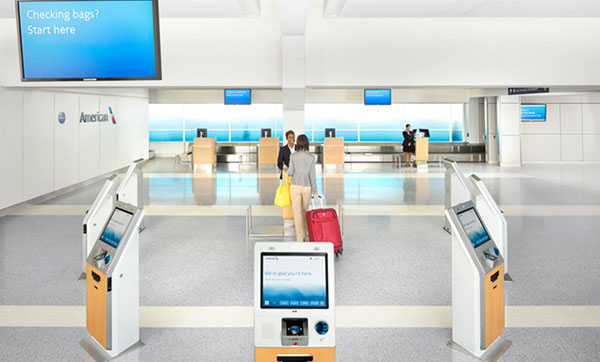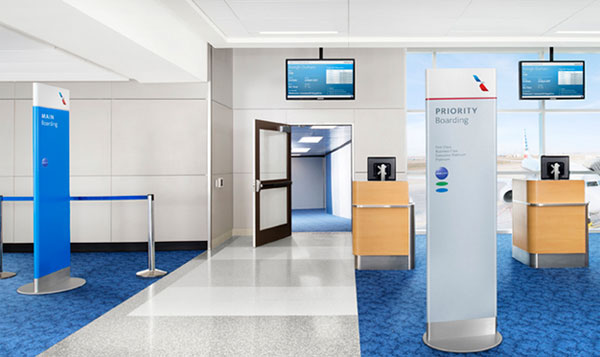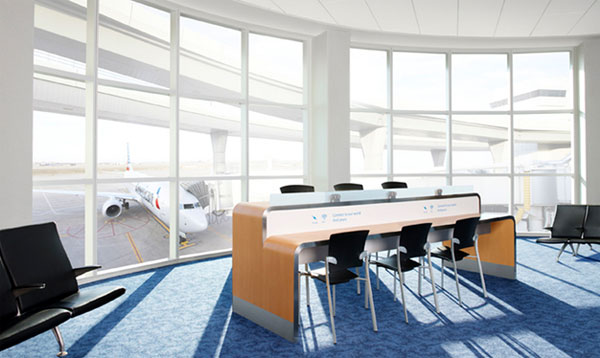A couple of months ago we read the Future Travel Experience (FTE) report on what American Airlines and Dallas Fort Worth teamed up to deliver around a “next generation airport.”
American Airlines and DFW took a collaborative approach, and hired an external consultant to come up with what the Next Generation Airport would look like – most of which was implemented by the end of 2013.
What did AA and DFW embrace as part of their Next Generation Airport?
- Free-standing kiosks in the check-in area, where passengers can check-in, print boarding passes, and bag tags – in tandem with a bag drop station. Because of this, queuing, even at peak hours of the day, is completely eliminated. Of course, there are still a few full-service check-in representatives for those with special needs and a dedicated check-in area for high priority guests.

- Digital screens at the security checkpoint highlighting waiting times in real time.
- The gates are designed around reducing congestion and keeping the customer relaxed.
- Introduced two separate boarding entrances to the airplane – one for the priority guest, and the other for everybody else – the goal was to reduce congestion.

- Installed digital screens to ensure all passengers are kept informed of boarding information, eliminating the need to continually pester the gate agent for information. Wherever a guest is sitting in the holding area at the gate, they are able to see at least one screen (design was optimized this way).
- Work desks and power stations in the gate area so that road warriors can continue to work up until the very moment of boarding.

- AA and DFW did research the possibility of automated self-boarding in their Next Generation Airport, similar to what is being done at McCarran International and Vienna International airports – but ultimately decided against it, opting to leave it for the future.
- Key to making this implementation of the Next Generation Airport successful was a change management plan that kept all stakeholders informed and up to date.
You may have also noticed a similar concept at New York Laguardia (LGA) – which was next on the list for AA’s Next Generation Airport. (Side note: even thought these airports have outfitted themselves as “Next Generation Airports” – their website and mobile technologies still need major upgrades to build the type of passenger experience that is required to sustain the Next generation Airport vision).
It’s important to think about these ideas in context with the thought leadership underway in the airport and aviation industry around a Next Generation Airport. Consider this presentation of the airport in 2025, unveiled by the Future Travel Experience Think Tank during their annual conference back in September 2013.
What is the 2025 Next Generation Airport vision that FTE paints?
it’s bold, but doable. All the technologies are here today and simply comes down to implementation, and probably a justification on the business case.
- All passengers arrive at airport checked-in.
- Baggage is already tagged. This can facilitated by “print at home” as well as RFID or beacon-enabled tags issued by the airlines. This concept is similar to the FlyBeacon Emirates prototype that we proposed at the Mashable Hackathon last Fall in Cambridge – the airlines would issue smart bag tags and with the help of beacons, your bag could be tracked and monitored throughout the airport in a transparent way that you would also have access to (via, say, a mobile app).
- Simple bag drop offered at a variety of locations.
- Automated baggage tracking and tracing – offered via mobile devices.
- Passenger is biometrically validated and issued with personalized ‘token’.
- ‘Token’ could be integrated with boarding pass and will be used to positively identify each passenger at each processing point.
- Security is streamlined, and consistent to avoid confusion.
- Border control is automated with all passengers using e-passports, and a limited number of roaming officers.
- Automated self-boarding of aircraft at gates.
- A cohesive passenger experience at bothe the departing and the arriving airport.
- The airport themes should reflect the culture, history, and culinary diversity of the city the airport is in. This is a concept tripchi has embraced from the beginning as a way to provide a unique guest experience different from anywhere else, causing passengers to linger, enjoy, and spend money.
Another idea that we rather resonated with in the Next Generation Airport study is the following premises, that will fundamentally shift how airports are operated:
- Focus on passenger needs and service
- Aircraft turnaround should be secondary consideration; not neglected but not prioritized at the expense of the passenger
- Historically the industry has had an engineering focus all about flying aircraft – the future is about flying customers and providing customer-orientated service
- No-one ‘owns’ the customer
- Passengers should be treated as guests
After all, passengers can choose to fly through other airports, and can also choose NOT to spend money. If we treat passengers like guests, and build an incentive structure to support that within the operations of the airport, then concepts like the Next Generation Airport will be embraced by the passenger – and the model will be financially viable for all airport stakeholders.
5 responses to “The Next Generation Airport”
[…] Leadership – The Next Generation Airport. A couple of months ago we read how American Airlines and the DFW Airport teamed up to deliver […]
[…] an airport Valentine’s Day this year. Did you have an airport Valentine’s Day? Read more here, and let us know your experience if you spent Feb 14th at the […]
[…] The controversy over Norwegian Air deals. Norwegian Air Shuttle, to many North Americans, is a little known European low cost carrier. It flies short-haul routes in Scandinavia and Europe. Lately, there have been some killer dealers (if you’re lucky enough to get them) – but there has been some controversy around exactly HOW these fares are being offered. Read more here. […]
[…] Don’t you hate that guy on the plane who…. Flying today can be a stressful endeavor and a good seatmate when you are flying solo is a crucial and horribly random. We have all been on a flight where our seatmate has severely put a damper on our experience. In the age of less seat pitch and decrease seat width, having an unruly seatmate can spell disaster for a long flight. Read more about these airplane passenger types here. […]
[…] Busiest airports for 4th of July Travel. The 4th traditionally begins the summer travel season where airports are packed to the gills. in this tripchi airport app blog, Seth highlights the 5 busiest airports in the US for the July 4th travel day as according to Hopper.com. Read more here. […]